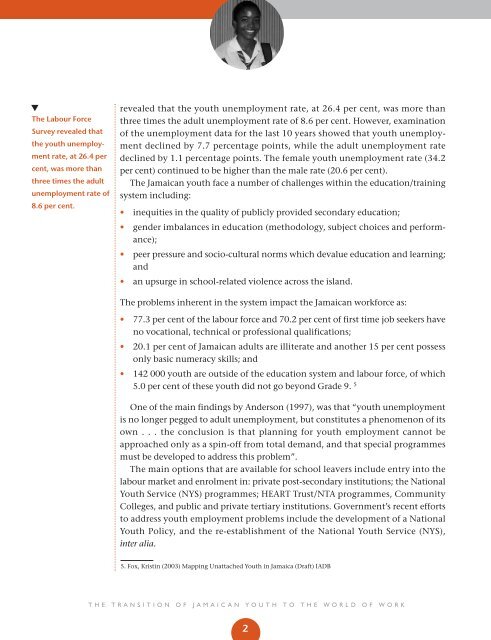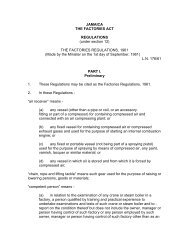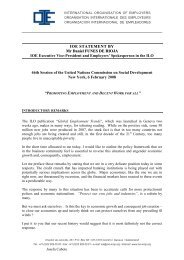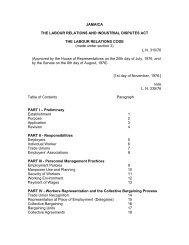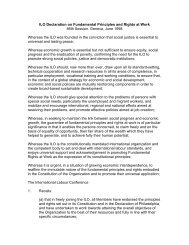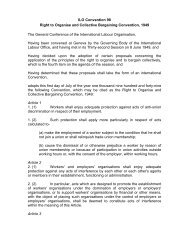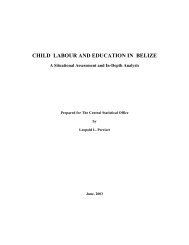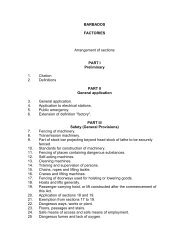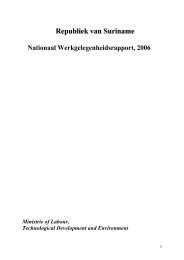The Transition of Jamaican - International Labour Organisation ...
The Transition of Jamaican - International Labour Organisation ...
The Transition of Jamaican - International Labour Organisation ...
Create successful ePaper yourself
Turn your PDF publications into a flip-book with our unique Google optimized e-Paper software.
<strong>The</strong> <strong>Labour</strong> Force<br />
Survey revealed that<br />
the youth unemployment<br />
rate, at 26.4 per<br />
cent, was more than<br />
three times the adult<br />
unemployment rate <strong>of</strong><br />
8.6 per cent.<br />
revealed that the youth unemployment rate, at 26.4 per cent, was more than<br />
three times the adult unemployment rate <strong>of</strong> 8.6 per cent. However, examination<br />
<strong>of</strong> the unemployment data for the last 10 years showed that youth unemployment<br />
declined by 7.7 percentage points, while the adult unemployment rate<br />
declined by 1.1 percentage points. <strong>The</strong> female youth unemployment rate (34.2<br />
per cent) continued to be higher than the male rate (20.6 per cent).<br />
<strong>The</strong> <strong>Jamaican</strong> youth face a number <strong>of</strong> challenges within the education/training<br />
system including:<br />
• inequities in the quality <strong>of</strong> publicly provided secondary education;<br />
• gender imbalances in education (methodology, subject choices and performance);<br />
• peer pressure and socio-cultural norms which devalue education and learning;<br />
and<br />
• an upsurge in school-related violence across the island.<br />
<strong>The</strong> problems inherent in the system impact the <strong>Jamaican</strong> workforce as:<br />
• 77.3 per cent <strong>of</strong> the labour force and 70.2 per cent <strong>of</strong> first time job seekers have<br />
no vocational, technical or pr<strong>of</strong>essional qualifications;<br />
• 20.1 per cent <strong>of</strong> <strong>Jamaican</strong> adults are illiterate and another 15 per cent possess<br />
only basic numeracy skills; and<br />
• 142 000 youth are outside <strong>of</strong> the education system and labour force, <strong>of</strong> which<br />
5.0 per cent <strong>of</strong> these youth did not go beyond Grade 9. 5<br />
One <strong>of</strong> the main findings by Anderson (1997), was that “youth unemployment<br />
is no longer pegged to adult unemployment, but constitutes a phenomenon <strong>of</strong> its<br />
own . . . the conclusion is that planning for youth employment cannot be<br />
approached only as a spin-<strong>of</strong>f from total demand, and that special programmes<br />
must be developed to address this problem”.<br />
<strong>The</strong> main options that are available for school leavers include entry into the<br />
labour market and enrolment in: private post-secondary institutions; the National<br />
Youth Service (NYS) programmes; HEART Trust/NTA programmes, Community<br />
Colleges, and public and private tertiary institutions. Government’s recent efforts<br />
to address youth employment problems include the development <strong>of</strong> a National<br />
Youth Policy, and the re-establishment <strong>of</strong> the National Youth Service (NYS),<br />
inter alia.<br />
5. Fox, Kristin (2003) Mapping Unattached Youth in Jamaica (Draft) IADB<br />
THE TRANSITION OF JAMAICAN YOUTH TO THE WORLD OF WORK<br />
2


